Assume data with structure like this: Demo
WITH CAL AS(
SELECT 2022 YR, '01' PERIOD UNION ALL
SELECT 2022 YR, '02' PERIOD UNION ALL
SELECT 2022 YR, '03' PERIOD UNION ALL
SELECT 2022 YR, '04' PERIOD UNION ALL
SELECT 2022 YR, '05' PERIOD UNION ALL
SELECT 2022 YR, '06' PERIOD UNION ALL
SELECT 2022 YR, '07' PERIOD UNION ALL
SELECT 2022 YR, '08' PERIOD UNION ALL
SELECT 2022 YR, '09' PERIOD UNION ALL
SELECT 2022 YR, '10' PERIOD UNION ALL
SELECT 2022 YR, '11' PERIOD UNION ALL
SELECT 2022 YR, '12' PERIOD ),
Data AS (
SELECT 2022 YR, '01' PERIOD, 10 qty UNION ALL
SELECT 2022 YR, '02' PERIOD, 5 qty UNION ALL
SELECT 2022 YR, '04' PERIOD, 10 qty UNION ALL
SELECT 2022 YR, '05' PERIOD, 7 qty UNION ALL
SELECT 2022 YR, '09' PERIOD, 1 qty)
SELECT *
FROM CAL A
LEFT JOIN data B
on A.YR = B.YR
and A.Period = B.Period
WHERE A.Period <10 and A.YR = 2022
ORDER by A.period
Giving us:
+------+--------+------+--------+-----+
| YR | PERIOD | YR | PERIOD | qty |
+------+--------+------+--------+-----+
| 2022 | 01 | 2022 | 01 | 10 |
| 2022 | 02 | 2022 | 02 | 5 |
| 2022 | 03 | | | |
| 2022 | 04 | 2022 | 04 | 10 |
| 2022 | 05 | 2022 | 05 | 7 |
| 2022 | 06 | | | |
| 2022 | 07 | | | |
| 2022 | 08 | | | |
| 2022 | 09 | 2022 | 09 | 1 |
+------+--------+------+--------+-----+
With Expected result of:
+------+--------+------+--------+-----+
| YR | PERIOD | YR | PERIOD | qty |
+------+--------+------+--------+-----+
| 2022 | 01 | 2022 | 01 | 10 |
| 2022 | 02 | 2022 | 02 | 5 |
| 2022 | 03 | 2022 | 03 | 5 | -- SQL derives
| 2022 | 04 | 2022 | 04 | 10 |
| 2022 | 05 | 2022 | 05 | 7 |
| 2022 | 06 | 2022 | 06 | 7 | -- SQL derives
| 2022 | 07 | 2022 | 07 | 7 | -- SQL derives
| 2022 | 08 | 2022 | 08 | 7 | -- SQL derives
| 2022 | 09 | 2022 | 09 | 1 |
+------+--------+------+--------+-----+
QUESTION: How would one go about filling in the gaps in period 03, 06, 07, 08 with a record quantity referencing the nearest earlier period/year. Note example is limited to a year, but gap could be on period 01 of 2022 and we would need to return 2021 period 12 quantity if populated or keep going back until quantity is found, or no such record exists.
LIMITS:
- I am unable to use table value functions. (No lateral, no Cross Apply)
- I'm unable to use analytics (no lead/lag)
- correlated subqueries are iffy.
Why the limits? this must be done in a HANA graphical calculation view. Which supports neither of those concepts. I've not done enough to know how to do a correlated subquery at this time to know if it's possible.
- I can create any number of inline views or materialized datasets needed.
STATISTICS:
- this table has over a million rows and grows at a rate of productlocationperiodsyears. so if you have 100020126=1.4 mil+ in 6 years with just 20 locations and 1000 products...
- each product inventory may be recorded at at the end of a month for a given location. (no activity for product/location, no record hence a gap. Silly mainframe save storage technique used in a RDBMS... I mean how do I know the system just didn't error on inserting the record for that material; or omit it for some reason... )
- In the cases where it is not recorded, we need to fill in the gap. The example provided is broken down to the bear bones without location and material as I do not believe it is not salient to a solution.
ISSUE:
- I'll need to convert the SQL to a "HANA Graphical calculation view"
- Yes, I know I could create a SQL Script to do this. This is not allowed.
- Yes, I know I could create a table function to do this. This is not allowed.
- This must be accomplished though Graphical calculation view which supports basic SQL functions
- BASIC Joins (INNER, OUTER, FULL OUTER, Cross), filters, aggregation, a basic rank at a significant performance impact if all records are evaluated. (few other things) but not window functions, not cross Join, lateral...
- as to why it has to do with maintenance and staffing. The staffed area is a reporting area who uses tools to create views used in universes. The area wishes to keep all Scripts out of use to keep cost for employees lower as SQL knowledge wouldn’t be required for future staff positions, though it helps!
For those familiar this issue is sourced from MBEWH table in an ECC implementation




